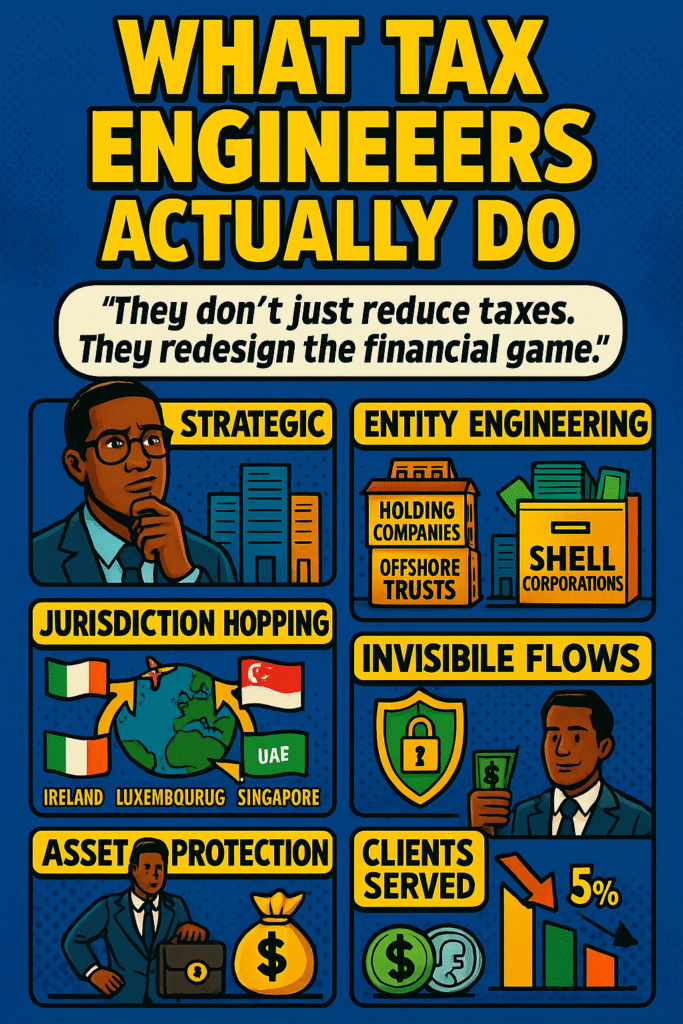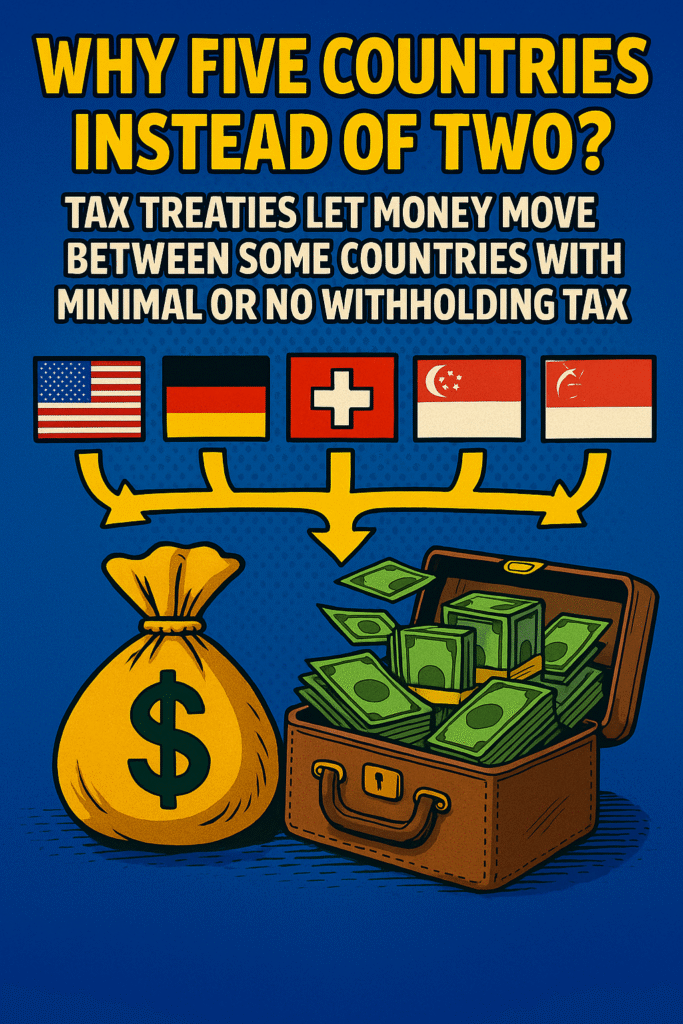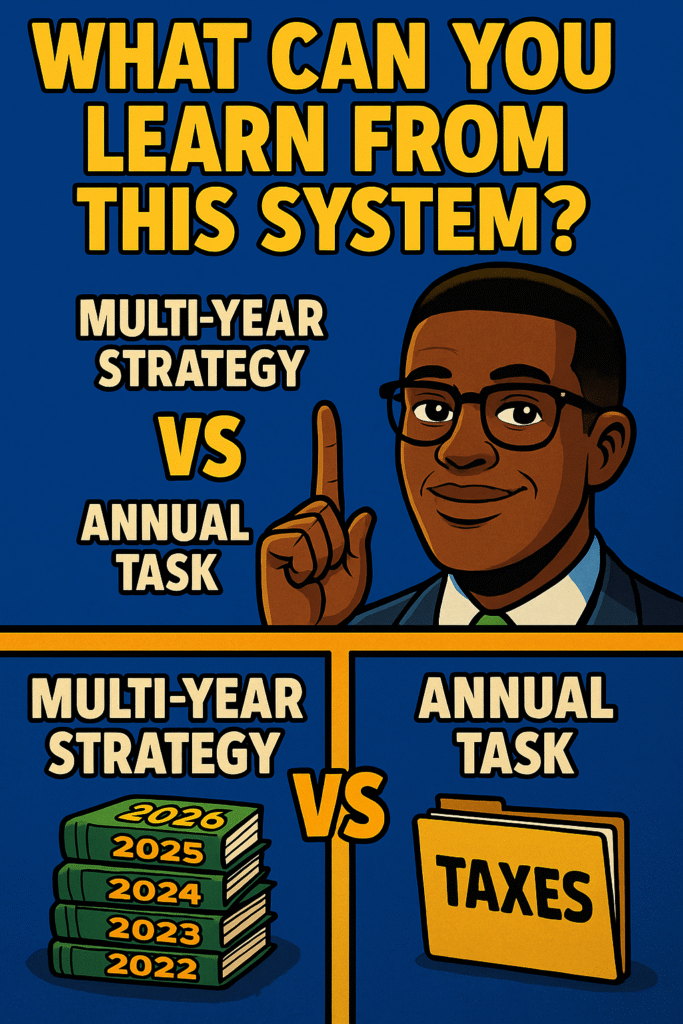Your basket is currently empty!
Most people see tax as an annual headache. It is the familiar process of gathering receipts, handing everything to an accountant, and then finding out what is owed to the government. For the ultra wealthy, however, tax is not an event. It is a carefully designed system. They do not simply file returns; they engineer financial structures with the precision of an architect.
At the heart of these strategies are Tax Engineers. These are not accountants who process tax returns. They are highly trained specialists who understand international tax law, treaties, and financial loopholes at a level that even governments struggle to match. Their role is to design legal systems that protect, move, and grow capital across borders.
This blog will reveal how wealthy individuals can legally move money across multiple countries in a single day, why the five-country flow is deliberate and strategic, what advantages they unlock, and what lessons everyday people can learn from this chess-like approach to taxation.
What Tax Engineers Actually Do

Tax Engineers do not focus on filing paperwork. They build systems. Instead of treating money as something static, they see it as fluid, capable of flowing through carefully chosen channels that reduce friction and increase efficiency. They rely on international tax treaties that dictate how income is taxed across borders. They plan currency flows so that capital grows without unnecessary losses from exchange or withholding taxes. They design corporate structures that use trusts, holding companies, and shell entities in legitimate ways to redirect money to more favourable jurisdictions.
They function less like bookkeepers and more like architects, designing a financial skyscraper where every company, trust, and bank account is strategically placed in the country that offers the best advantage.
What Does It Mean to Shift Money Through Five Countries?

When you hear that the wealthy move money across five jurisdictions in one day, it may sound like a plot from a Hollywood thriller. In reality, it is a legal and pre-structured financial design that relies on global banking APIs, instant settlement platforms, high-frequency transfers, and precise time zone coordination. Money can be transferred across borders in as little as three hours, flowing from one jurisdiction to the next in a carefully choreographed sequence.
For example, wealth may begin in the United States, which has high corporate and personal tax rates. From there, profits might be directed to Ireland, a country famous for its low corporate tax. Next, the flow passes through Luxembourg, which offers favourable holding structures and access to EU tax benefits. After that, capital moves to Singapore, where dividends are taxed lightly and financial stability is prized. Finally, the funds reach the United Arab Emirates, a jurisdiction with zero personal income tax, generous residency laws, and strong asset protections.
Each stage in this chain is chosen for a reason, and together they create a corridor that minimizes friction, maximizes exemptions, and reduces the overall tax bill.
Why Five Countries Instead of Two?

The number is not arbitrary. Every stop on the journey adds value in a different way. Tax treaties between certain nations allow money to move across borders with little or no withholding tax. Local exemptions in some jurisdictions mean that foreign-earned income, dividends, or interest can be brought in tax-free. Legal protections in particular countries provide stronger corporate shields or confidentiality. Time zone differences can be used to schedule transfers to take advantage of market openings and closings, while currency choices allow investors to take advantage of stability or hedging opportunities.
By the time money has travelled through this chain, it has retained more of its value than if it had simply been moved directly. What looks complicated from the outside is, in fact, a precisely designed system where every country plays a role in protecting wealth.
What Does This Achieve?

The purpose of routing capital in this way is not just to make things more complex. It delivers concrete financial results. By using treaties, exemptions, and protections, wealthy families and corporations can avoid withholding taxes that governments normally take when money crosses borders. They can lower capital gains taxes by passing income through countries that offer reduced or zero rates. They can minimize corporate income tax by directing profits into the jurisdictions with the lowest rates. And they can access special exemptions such as tax holidays, corporate rebates, or residency perks.
For those at the top, the difference is enormous. A corporation that would pay 40 percent in one country may end up with an effective tax rate of only 5 percent when using this method.
Is It Legal?

Yes, when carried out correctly, this system is entirely legal. Tax Engineers operate inside the law. They do not hide income or falsify documents. Instead, they use the laws as written, exploiting the fact that no single government writes its tax codes with global coordination in mind. The difference between tax evasion and tax engineering is crucial. Evasion is illegal and punishable. Engineering is legal, strategic, and designed to minimize the bill without breaking any rules. The wealthy are not avoiding the game, they are simply playing it on a far more advanced level.
Why Don’t Average People Know This?

The average taxpayer rarely hears about these strategies for several reasons. Schools do not teach global tax flows, and even universities focus on domestic rather than international systems. To most people, the idea sounds too complex to even attempt. It also requires global legal knowledge that only elite specialists possess. And while the majority of people think of taxes as something to deal with once a year, the wealthy think of them as a long-term strategy that requires constant attention.
In short, ordinary earners are playing checkers while the ultra wealthy are playing chess.
What Can You Learn from This System?

You may not have billions to move across borders, but you can learn from the mindset. Think of your taxes as a multi-year strategy rather than an annual task. Recognize that jurisdiction matters. Where your business is registered, where your bank accounts are located, and where you live can all affect how much you keep. Explore legal vehicles such as trusts, limited companies, and even offshore accounts that can provide better protection and efficiency than a standard savings account. Above all, understand that every pound saved in tax is not just a saving, it is an opportunity to reinvest and compound wealth.
Anyone can benefit from adopting a strategic, multi-year approach to taxes not just those moving vast sums across borders. By thinking like a global business and using available legal tools, it’s possible to structure finances for better protection, efficiency, and growth. Helpful links below offer step-by-step guides, resources, and expert services to help build your own system.
Key Principles and Mindset
- Treat tax planning as an ongoing strategy, not a last-minute annual task.meegle
- Understand that your country of residence, where you earn, and where you bank all impact your taxes.holbornassets
- Legal entities like trusts, limited companies, or offshore accounts can provide serious advantages beyond typical bank accounts.meegle
- Every amount saved in tax can be reinvested to compound your wealth
How to Get Started
- International Tax Optimization Guide: Start with this comprehensive primer on the principles and benefits of international tax optimizationincluding compliance tips, common tools, and actionable steps.meegle
- Beginner’s Guide for Expats and Business Owners: Use this resource for a friendly introduction to tax planning fundamentals valuable for any individual or entrepreneur starting out.expattaxes
- Professional Advice: Firms like Deloitte, PwC, and EY offer tax advisory services for complex structures; connecting with experts ensures compliance and maximizes savings.holbornassets
Tools, Structures, and Resources
- Legal Vehicles:
- Explore setting up a limited company or trust to separate personal and business assets offering legal protections and flexible tax treatment.
- Investigate the pros and cons of offshore accounts and what’s legally possible for residents in your country.
- Tax Treaties: Learn about using tax treaties for reduced withholding and to avoid double taxation on cross-border income.
- Global Tax Management Platforms: Consider software like Thomson Reuters ONESOURCE or Avalara for managing multi-country tax filings if you operate internationally.
Actionable Steps
- Assess your current tax position and identify key jurisdictions that affect you.
- Consult with specialists in international or expat tax law before making major changes.
- Regularly update your knowledge tax laws and treaties change faster than you might expect.
Helpful Links
- Comprehensive International Tax Optimization Guide meegle
- How to Minimize Tax Liabilities Globally holbornassets
- Beginner’s Guide to Tax Planning expattaxes
- 11 Key Strategies for Expats brighttax
- Guide to Global Tax Management cbh
Building your own system starts with education, then gradually layering in professional resources and digital tools to fit your evolving needs.brighttax
In Closing
Tax Engineers operate in a hidden world where money flows across borders at lightning speed, using laws in ways that governments themselves often fail to anticipate. For the ultra wealthy, this system acts as both a shield and a growth engine, ensuring their wealth is preserved across generations.
For everyone else, it is a reminder that taxes are not simply about filling out forms. They are about structure, strategy, and playing the long game. By shifting your perspective from filing to engineering, you begin to understand the rules in the same way the ultra wealthy do and once you see the system, you can never look at taxes the same way again.


0 responses to “The Secret World of Tax Engineers: How the Ultra Wealthy Legally Move Money Across 5 Countries to Pay Less Tax”